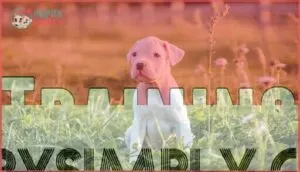This site is supported by our readers. We may earn a commission, at no cost to you, if you purchase through links.
The powerful and loyal Dogo Argentino is a breed originating from Argentina in 1928. Bred from diverse canine breeds, this muscular, white-coated dog stands 24-26.5 inches tall and can weigh 80-100 pounds.
With an impressive bite force of 500 PSI, the Dogo Argentino is a formidable protector, but requires experienced owners to properly train and socialize this intelligent and athletic breed.
While the Dogo can make a loving family companion, they have the potential for aggression if not properly handled. Potential owners must consider the Dogo’s shedding, health issues, and exercise needs.
For the right owner, the Dogo Argentino’s devotion is unmatched.
Table Of Contents
- Key Takeaways
- Breed Overview
- Bite Force
- Aggression
- Health
- Training
- Basic Training
- Advanced Training
- Specialty Training
- Behavioral Training
- Positive Reinforcement
- Consistency and Patience
- Professional Help
- Early Socialization
- Continuous Socialization
- Socialization With Other Dogs
- Socialization With Humans
- Socialization With Other Animals
- Socialization in Different Settings
- Socialization for Different Purposes
- Living With a Dogo Argentino
- Owning a Dogo Argentino
- Frequently Asked Questions (FAQs)
- Conclusion
Key Takeaways
- The Dogo Argentino is a powerful breed with an impressive bite force of 500 PSI, requiring experienced owners who can properly train and socialize the dog.
- Aggression towards humans and other dogs is a common issue with the Dogo Argentino breed, and proper socialization and temperament testing are essential.
- Responsible breeding practices are crucial for the health and well-being of the Dogo Argentino, including genetic testing, pedigree analysis, and health screening.
- Providing the Dogo Argentino with ample exercise, a balanced diet, and regular veterinary care are paramount for the breed’s overall well-being and longevity.
Breed Overview
Intrigued by the Dogo Argentino’s compelling origins and history? This potent yet faithful breed boasts an impressive standard, with acknowledgment and vogue across the globe. From its exceptional hunting abilities to its intricate temperament, the Dogo Argentino is a breed that demands prudent thought regarding health, care, training, and socialization. Let’s delve deeper into the particulars.
Origins and History
The Dogo Argentino, a breed renowned for its formidable bite force and devotion, has an intriguing past. Originating in Argentina in 1928, this breed was conceived by Dr. Antonio Nores Martinez, who sought to create a dog that merged the vigor and agility of diverse breeds, such as the Cordoba fighting dog, Pointer, Great Dane, Bull Terrier, Boxer, Bulldog, Pyrenean Mastiff, and Irish Wolfhound.
The breed was developed with an emphasis on pursuing large game such as wild boar and puma, as well as its unwavering bravery and loyalty as a companion. The Dogo Argentino rapidly gained favor among hunters in the western United States. Notwithstanding its formidable hunting abilities, the breed has encountered challenges owing to its ancestry of fighting dogs, which has raised concerns regarding aggression and suitability for inexperienced owners.
The Dogo Argentino is a substantial breed, with males reaching heights of 24-26.5 inches and females standing at 24-25.5 inches tall, weighing between 80-100 pounds. This breed is distinguished by its short, white coat and muscular frame. The Dogo Argentino isn’t merely a potent hunter but also a versatile breed, adept at fulfilling various roles, ranging from a family protector to a spirited playmate.
The breed’s prominence has burgeoned over the years, with the Dogo Argentino receiving recognition from the Argentine Kennel Club in 1964, FCI in 1973, and the American Kennel Club in 2020. Despite its potential as a hunting and guard dog, the Dogo Argentino isn’t appropriate for all due to its strong-willed nature, necessitating a resolute, experienced owner.
Breed Standard
The Dogo Argentino breed standard mirrors its genesis and function. Developed in Argentina in the 1920s, the breed emerged from a blend of diverse breeds, including the Viejo Perro de Pelea Cordobés, Pointer, Great Dane, Bull Terrier, Boxer, and Bulldog. Initially utilized for dog fighting and hunting large game, the breed necessitated a canine not just robust and athletic but also endowed with a keen sense of scent and the capacity to trail quarry.
The Dogo Argentino’s breed standard has undergone refinement over time to embody the breed’s historical significance and cultural influence. It’s a formidable and imposing dog, renowned for its brief white coat and muscular physique. The breed exhibits intelligence, athleticism, and bravery, rendering it a sought-after companion for those seeking a loyal and affectionate friend.
The breed standard concurrently underscores the Dogo Argentino’s assertive nature, which can pose challenges to novice owners. The breed demands a capable owner who can impartially train and socialize it to control its potential aggression against other dogs and strangers.
Regarding care and upkeep, the Dogo Argentino is a breed that requires considerable attention, necessitating consistent exercise and a well-balanced diet to sustain its well-being. Its short white coat sheds moderately and necessitates periodic grooming to eliminate loose hair.
Recognition
Recognized worldwide, Dogo Argentino‘s bite force is 500 PSI, making it a powerful protector.
Popularity
Despite legal restrictions, the Dogo Argentino’s loyal temperament bolsters its popularity as a protector.
Hunting Abilities
Discover the hunting prowess of the Dogo Argentino, a breed known for its powerful nose, lung capacity, and aggressive instincts.
Temperament
Comprehending the Dogo Argentino’s disposition is essential for prospective owners. This breed is renowned for its resilience and possible aggression, demanding knowledgeable, resolute, and consistent owners.
Dogos may exhibit aggression toward unfamiliar dogs, individuals, and even known dogs. Nonetheless, they’re also devoted, affectionate, and expressive companions that flourish in close proximity with their families.
With appropriate training and socialization, Dogos can become suitable family dogs, but they aren’t advised for inexperienced owners or those desiring a low-effort pet.
Health Issues
Understand Dogo Argentino health issues for responsible ownership.
Care and Training
Essential for your Dogo Argentino’s well-being are care and training. Grooming, feeding, exercise, and activities are vital parts of their care. Training should be consistent and positive, focusing on their natural instincts.
Socialization
Socialize early, continuously, with animals, in varied settings, for a well-rounded companion.
Living Conditions
Living Conditions for a Dogo Argentino are paramount for their well-being and contentment. This formidable breed necessitates ample room to roam and exercise, preferably on a farm or ranch, where they can investigate and indulge in their innate hunting inclinations. They flourish in environments that ignite their intellect and bodies, as they may become listless and disruptive if their requirements aren’t fulfilled.
A Dogo Argentino’s exercise requisites are substantial, and they require a minimum of 60 minutes of vigorous exercise each day to preserve their physical and mental well-being. They’re also predisposed to hip dysplasia, a common orthopedic ailment afflicting large dog breeds, which can result in arthritis as they mature. Accordingly, providing them with an enclosed yard for play and leash-controlled walks is indispensable for their health and fitness.
Regarding dietary requirements, Dogo Argentinos necessitate a regimen tailored for large breed dogs with an abundance of fresh, uncontaminated water. They’re a highly energetic breed, so their feeding needs will fluctuate from puppyhood to adulthood. Routine veterinary examinations and dental care are also vital to avert health concerns.
Developing a close bond with a Dogo Argentino is a gratifying endeavor, as they’re renowned for their fidelity and affection for their owners. They’re also discerning and trainable, rendering them suitable for diverse roles, including hunting, law enforcement, search and rescue, and even service dogs.
Bite Force
You may be surprised to learn that the Dogo Argentino packs an impressive bite force of 500 PSI, rivaling some of the most powerful canines. While this strength makes the breed well-suited for hunting and protection, it also requires experienced owners who can properly train and socialize these dogs to prevent aggressive behavior.
Measuring Bite Force
Understanding bite force is essential for dog training and safety. Measured in PSI units, it’s a critical aspect of dog behavior and aggression prevention.
Dogo Argentino’s Bite Force
The Dogo Argentino’s bite force, measured in pounds per square inch (PSI), is an impressive 500 PSI. This strength is a result of its powerful jaw and is an essential trait for hunting and protecting.
Comparing Bite Forces
The Dogo Argentino, a robust and athletic breed, is renowned for its formidable bite force. Comparing bite forces among different breeds can offer valuable insights into their hunting prowess and temperament. Here are three key points to be aware of:
- Bite Force Comparison: The Dogo Argentino’s bite force is estimated at 500 PSI (pounds per square inch), which is considered substantial among dog breeds. This strength is essential for the breed’s original role as a hunting dog, enabling it to track, attack, and secure prey.
- PSI Measurement: PSI is a standardized unit used to measure the pressure applied to a single square inch of space. While it isn’t possible to accurately measure a dog’s bite force on such a small area, the results are typically averaged to provide a general understanding of the breed’s bite strength.
- Impact on Prey: A strong bite force is vital for hunting dogs like the Dogo Argentino, as it allows them to subdue their prey effectively. This strength, combined with their powerful jaws and lung capacity, makes them formidable hunters.
It is crucial to remember that a strong bite force doesn’t necessarily make a breed aggressive or dangerous. The Dogo Argentino, while powerful, can be a loving and loyal companion with proper socialization and training.
Impact on Prey
Dogo’s hunting style showcases dominance, with pack behavior enforcing a clear social hierarchy over prey instincts.
Safety Considerations
As a responsible dog owner, knowing the bite force of your Dogo Argentino is vital for safety. With a bite force of 500 PSI, this breed is strong and can break bones. However, it’s important to remember that bite force alone doesn’t determine a dog’s aggression or potential hazard. The Dogo Argentino’s bite force is just one part of its overall behavior and temperament.
To reduce the risk of aggressive behavior, proper training and socialization are key from a young age. This includes teaching your Dogo Argentino good behavior and lessening the chance of aggression towards people and other animals. Always watch your dog around children and other pets, and make sure your yard is securely fenced to prevent escapes.
In some cases, breed-specific laws may restrict or ban certain breeds, including the Dogo Argentino, in certain areas. It’s important to check local regulations and make sure you can legally have this breed in your area.
Training and Socialization
Train your Dogo Argentino with patience and consistency. Start with basic obedience, leash and crate training. Clicker training can help reinforce positive behaviors. Enroll in puppy socialization classes.
Preventing Aggression
To avert aggression in your Dogo Argentino, it’s vital to establish leadership and control triggers from an early age. Here are some steps to follow:
- Establish leadership: Dogo Argentinos are strong-willed and independent, so it’s imperative to demonstrate that you’re the alpha. Utilize positive reinforcement training methods, such as clicker training or reward-based training, to teach your dog that adhering to your commands will lead to positive outcomes.
- Control triggers: Dogo Argentinos can be responsive to certain stimuli, such as other dogs, strangers, or loud noises. To avert aggression, manage your dog’s environment by keeping them away from triggers whenever possible. If you’re unable to evade triggers, use desensitization techniques to help your dog become accustomed to them.
- Early intervention: Socialization is key to preventing aggression in Dogo Argentinos. Start socializing your dog from a young age, exposing them to a variety of situations, people, and other animals. This will help them learn to recognize friendly behavior and reduce the likelihood of aggression.
- Responsible ownership: Guarantee that you provide your Dogo Argentino with ample physical and mental exercise, as well as a balanced diet and regular veterinary care. A healthy, well-cared-for dog is less likely to exhibit aggressive behaviors.
- Consistent training: Dogo Argentinos require firm, consistent training. Be patient and persistent, and remember that training should be a positive experience for both you and your dog.
Legal Implications
As a conscientious owner of a Dogo Argentino, it’s paramount to comprehend the juridical ramifications of possessing a canine with such a potent bite force. While the breed isn’t inherently aggressive, it’s vital to acknowledge that the Dogo Argentino was cultivated to pursue, assault, and apprehend prey**, which can render them formidable and potentially hazardous if not managed appropriately.
One of the most significant juridical implications is the prospect of culpability in the event of a bite or assault. Insurance providers may not furnish culpability coverage for Dogo Argentino owners, making it imperative to consult with your insurance agent prior to acquiring a puppy. Furthermore, in certain nations, the breed is proscribed or constrained, necessitating particular permits or importation regulations.
Breed prejudice is another concern, as the Dogo Argentino’s notoriety as a combat breed has occasioned its inclusion on proscribed rosters in numerous countries. This can render it challenging to locate a Dogo Argentino for adoption or acquisition, and it’s vital to guarantee that any breeder adheres to ethical practices and prioritizes the well-being of their canines.
Responsible breeding practices are fundamental to addressing potential health concerns, such as hip dysplasia and deafness, which can manifest in the breed. By selecting a reputable breeder who conducts requisite health screenings and provides a nurturing environment for the puppies, you can aid in ensuring that your Dogo Argentino is hale and content.
Aggression
As a Dogo Argentino owner, you should be aware that the breed is considered aggressive due to its fighting dog ancestry. However, with proper socialization and training, Dogo Argentinos can make loyal and loving family companions if handled responsibly.
Breed Characteristics
Dogo Argentinos, Argentina’s esteemed export, flaunt a spotless coat, remarkable height (24–26.5 inches), and substantial weight (80–100 pounds).
Aggression Towards Humans
Understand your Dogo Argentino’s aggression triggers. Temperament testing can help. As an owner, you bear responsibility for your pet’s behavior. Breed reputation doesn’t define your dog. Legal liabilities for aggressive dogs are real.
Aggression Towards Other Dogs
Aggression directed at other dogs is a common issue with the Dogo Argentino breed. It’s essential to guarantee adequate socialization and character assessment. Breed compatibility, dog socialization, and accountable ownership are central considerations in handling aggression.
Reducing Aggression
To reduce aggression in your Dogo Argentino, focus on early socialization, temperament testing, and responsible ownership. Engage in aggression management techniques, and guarantee breed-specific legislation is followed.
Breeding for Temperament
As a responsible dog owner, you appreciate the significance of breeding practices in molding the temperament of your Dogo Argentino. This formidable breed, celebrated for its loyalty and strength, can be an exceptional companion with the appropriate leadership. Here are some pivotal points to ponder when breeding for temperament:
- Socialization: Early socialization is intrinsic for establishing a steady, discriminating temperament in Dogo Argentinos. This entails exposing them to a range of environments, individuals, and other animals from an early age. Effective socialization aids them in recognizing welcoming behaviors and diminishes the probability of aggression toward strangers or other dogs.
- Genetic Influence: Temperament is impacted by both nature and nurture. While the inheritance of temperament is less predictable than physical traits, selective breeding can assist in guaranteeing that desirable traits are passed down from generation to generation. Breeding dogs with steady temperaments can help reduce the risk of aggression in offspring.
- Temperament Testing: Breeders should conduct temperament tests on potential breeding dogs to assess their suitability for breeding. This can include evaluating their reaction to strangers, their playfulness, and their ability to interact with other dogs. Dogs with steady, friendly temperaments are more likely to produce offspring with similar traits.
- Selective Breeding: Breeding dogs with desirable temperaments and good health can help reduce the likelihood of aggression and other behavioral issues. Responsible breeders prioritize the health and temperament of their dogs, conduct necessary health screenings, and provide a nurturing environment for the puppies.
Responsible Ownership
As a responsible Dogo Argentino owner, it’s essential to grasp the breed’s unique traits and necessities. This assertive breed, renowned for its devotion and athleticism, requires adult oversight, leash instruction, and socialization groups to guarantee a collaborative and secure environment for both the dog and its family. Here’s a table to aid in understanding the vital principles of responsible Dogo Argentino ownership:
| Aspect | Description |
|---|---|
| Adult Supervision | Always oversee children and dogs while together to prevent accidents. |
| Leash Training | Keep your Dogo Argentino on a leash in public areas to control their hunting drive and protect other animals. |
| Socialization Classes | Register your Dogo Argentino in socialization classes to assist them in interacting with other dogs and humans in a controlled environment. |
| Responsible Breeding | Select a respected breeder who prioritizes the well-being and demeanor of their dogs, conducts mandatory health screenings, and provides a nurturing environment for the puppies. |
| Training | Invest in skilled training to help your Dogo Argentino acquire obedience and socialization skills. |
| Exercise | Provide your Dogo Argentino with regular exercise to maintain their mental and physical well-being. |
| Health Care | Ensure your Dogo Argentino receives regular veterinary care and follows a balanced diet to maintain their health. |
Health
As a Dogo Argentino owner, you’ll need to be proactive about your pup’s health. Regular veterinary checkups, a nutritious diet, and adequate exercise are essential for preventing common issues like canine hip dysplasia and maintaining your Dogo’s overall well-being.
Common Health Issues
Understanding and addressing typical health problems is paramount for conscientious Dogo Argentino ownership. Periodic health exams and genetic screening can mitigate veterinary costs and guarantee breed preservation. Breeding responsibly is fundamental to upholding the well-being and health of these robust guardians.
Breeding for Health
Importance of Responsible Breeding for Dogo Argentino
For the health and well-being of the Dogo Argentino breed, responsible breeding practices are essential. Here are key points to keep in mind:
- Genetic Testing: Before breeding, it’s imperative to conduct genetic testing on both parents to identify potential health issues and guarantee healthy offspring. This can reduce the risk of passing on genetic disorders and maintain the breed’s overall health.
- Pedigree Analysis: Analyzing the pedigree of the potential breeding pair can provide valuable information about the breed’s health history. This can help identify any common health issues or genetic predispositions and inform breeding decisions.
- Health Screening: Regular health screenings for both parents and their offspring can help detect any health issues early on. This allows for prompt treatment and can prevent the spread of genetic disorders within the breed.
- Genetic Diversity: Maintaining genetic diversity is crucial for the breed’s long-term health. This can be achieved by breeding dogs from diverse backgrounds and avoiding inbreeding, which can lead to increased health issues.
- Responsible Breeding Practices: Reputable breeders prioritize the health and well-being of their dogs, conduct necessary health screenings, and provide a nurturing environment for the puppies. This ensures you receive a healthy and happy pup while discouraging unethical breeding practices.
Preventative Care
Preventative care is your Dogo’s armor against health woes, a stitch in time that saves nine.
- Balanced Nutrition: Fuel their fire.
- Regular Grooming: Shine, not shed.
- Exercise: A fit Dogo is a fortress.
- Microchipping: Never lose your shadow.
- Health Checks: Early detection, early peace.
Veterinary Care
As a responsible Dogo Argentino owner, you recognize the significance of consistent veterinary care for your cherished companion. Veterinary examinations, vaccinations, deworming, and dental checkups are paramount to preserving your dog’s well-being and warding off potential health concerns.
During veterinary examinations, your Dogo Argentino will undergo a comprehensive check-up to detect any potential health issues. Vaccinations are essential to safeguard your dog from various diseases, and your veterinarian will prescribe a vaccination schedule tailored to your dog’s age and lifestyle. Deworming is also imperative to curb the transmission of intestinal parasites, which can cause discomfort and potentially escalate to more severe health issues.
Dental checkups are indispensable for maintaining your Dogo Argentino’s oral health. These checks can help avert dental disease, which is prevalent in the breed and can lead to more serious health problems if neglected. Regular dental care at home, including brushing your dog’s teeth at least twice a week, can also contribute to maintaining the health of their teeth and gums.
Nutrition
As a Dogo Argentino owner, you recognize the significance of supplying your canine companion with a well-rounded and nourishing diet to uphold their health and well-being. This breed has particular dietary requirements, and it’s essential to select the appropriate food to guarantee their flourishing. Here are some significant aspects to keep in mind when feeding your Dogo Argentino:
- High-Protein Diet: Dogo Argentinos necessitate a diet rich in protein to maintain their muscular structure and active lifestyle. Seek out foods with a protein content of at least 25%.
- Calcium and Fat Content: Verify that the food contains adequate levels of calcium (1.5%) and fat (9%) to support their skeletal development and general health.
- Avoid Overfeeding: Excessive feeding can result in obesity and associated health problems. Feed your Dogo Argentino in accordance with their age, weight, and activity level.
- Food Allergies and Sensitivities: Be mindful of prevalent allergens, including beef, dairy, wheat, egg, and chicken, and refrain from using them if your Dogo Argentino has food allergies or sensitivities.
- Supplements: Contemplate incorporating supplements, such as fish oil, into their diet to bolster their skin, hair, heart, kidneys, and joints.
- Meal Frequency: Provide your Dogo Argentino with two large meals per day upon reaching adulthood, adapting to their activity level and individual requirements.
- Consult Your Veterinarian: Consistently seek advice from your veterinarian to determine the suitable food and feeding schedule for your Dogo Argentino.
Exercise
Engage your Dogo Argentino’s powerful energy with exercise routines designed specifically for their breed. Running, agility training, and organized walks are essential for their health and well-being.
Grooming
Keep your Dogo Argentino’s coat looking its best with these grooming tips:
- Brush regularly to manage shedding.
- Bathe only when necessary, using a gentle shampoo.
- Trim nails as needed.
- Check ears for dirt and debris.
Training
Training a Dogo Argentino takes commitment, consistency, and patience. You’ll need to focus on basic obedience, advanced commands, and socialization from an early age to curb the breed’s natural protective instincts and potential aggression.
Basic Training
Commencing on leash training your Dogo Argentino? It’s an expedition of reciprocal deference. Crate training and toilet-training are your fundamental pillars, while obedience directives and clicker training mold a well-behaved protector. Bear in mind, constancy is your steadfast ally in this training sojourn.
Advanced Training
As your Dogo Argentino grows, it’s time to focus on advanced training. This includes teaching more complex commands and continuing temperament training. Socialization challenges may arise, so be aware of legal responsibilities. Remember, consistency and patience are key.
Specialty Training
As your Dogo Argentino grows, it’s time to explore specialty training. This breed is known for its powerful bite force and loyalty, making them excellent for off-leash training, obedience, tracking, and protection. Here are four ways to enhance your Dogo’s skills:
- Off-leash training: Teach your Dogo to follow commands without a leash, allowing them to exercise freely while staying obedient.
- Obedience training: Strengthen the bond between you and your Dogo by teaching them basic commands like sit, stay, and come.
- Tracking training: Develop your Dogo’s natural instinct to track by teaching them to follow scents and locate hidden objects.
- Protection training: Teach your Dogo to protect you and your family by responding to intruders or dangerous situations.
Behavioral Training
As your Dogo Argentino grows, it’s essential to handle behavioral issues. Indifference training can aid in controlling aggression, while socialization strategies are indispensable for a well-developed dog. Training techniques should be firm but just, emphasizing positive reinforcement whenever feasible. Bear in mind, patience and consistency are fundamental.
Positive Reinforcement
Positive reinforcement is a critical aspect of Dogo Argentino training. Use training equipment like clickers and treats to incentivize your dog. Establish pack leadership through dominance theory, but avoid excessive force. Remember, patience is essential.
Consistency and Patience
Consistency and patience are key when training a Dogo Argentino. Understanding their temperament variation and breed suitability can help manage aggression and improve family compatibility. Training challenges may arise, but with persistence and positive reinforcement, your Dogo Argentino can become a loyal and loving companion.
Professional Help
Regarding training your Dogo Argentino, expert assistance can be exceedingly beneficial. Behavioral control methods, such as addressing aggression triggers, are vital for your dog’s growth. Bear in mind, ownership obligation encompasses both assessing temperament and continuous training.
Early Socialization
Essential socialization is pivotal for your Dogo Argentino puppy’s development. It aids in mitigating fear, fostering a sense of belonging within a pack, and promoting emotional stability. The optimal time for socialization spans the initial three months of your puppy’s life, as this period indelibly molds their future disposition and conduct.
Gradually exposing your puppy to a diverse range of individuals, environments, and scenarios can profoundly impact their temperament. Initiate by introducing them to varying types of people, encompassing young and elderly individuals, those adorned with facial hair, eyewear, or head coverings, and individuals utilizing canes or wheelchairs. Acquaint them with an array of sounds, such as sirens and vacuum cleaners, and dissimilar textures, including carpet, hardwood, tile, and linoleum surfaces.
Render these experiences positive by offering rewards and commendations. Fragment treats into diminutive portions to facilitate digestion by your puppy. Additionally, strive to maintain composure and refrain from overwhelming your puppy with an excessive influx of stimuli simultaneously.
Engage the entire family in the socialization process to assist your puppy in acclimating to different individuals. Proceed cautiously, incrementally exposing them to a broader range of stimuli and novel experiences. Commence with a select few family members, subsequently introducing them to individual strangers.
Once your puppy exhibits tolerance for a modest level of stimuli, venture into public spaces such as pet stores, acquaintances’ residences, and various streets within your neighborhood. This will equip them with the ability to navigate diverse situations appropriately and derive pleasure from interacting with a variety of people.
Continuous Socialization
Ongoing socialization is paramount for your Dogo Argentino’s well-being and behavior. Following early socialization, it’s imperative to maintain a steady stream of social interactions to guarantee your dog remains well-adjusted and assured. Here are some methods to perpetuate socializing your Dogo Argentino:
- Group classes: Enroll your dog in group training classes where they can master basic obedience and interact with other dogs and people. This will assist them in developing good manners and versatility.
- Puppy playdates: Arrange playdates with other dogs to provide opportunities for your dog to hone social skills and learn to share toys and space.
- Enrichment activities: Engage your dog in activities that stimulate their mind and body, such as agility training, scent work, or interactive games.
- Breed-specific events: Attend events designed for the Dogo Argentino breed, where your dog can meet other Dogo Argentinos and their owners. This can aid your dog in feeling a sense of belonging and learning from other dogs of the same breed.
Socialization With Other Dogs
When socializing your Dogo Argentino with other dogs, timing is key. Choose neutral venues to avoid territorial tiffs, and use positive reinforcement to navigate the obstacles of canine communication. It’s a dance of diplomacy, where every paw step counts.
Socialization With Humans
Integrating your Dogo Argentino with humans is essential for its holistic growth. Introduce your dog to diverse settings, including children and seniors, to prevent hostility. Dog parks can be advantageous, but ascertain that your dog is well-behaved and steers clear of potential confrontations. Bear in mind, a well-integrated Dogo Argentino is a contented, self-assured companion.
Socialization With Other Animals
Socializing your Dogo Argentino with other animals is essential for their well-being. Begin socialization early and introduce them to various animals, including dogs, cats, and even birds. Consider dog parks, but make sure they’re suitable for their age and are supervised. Animal behaviorists recommend socialization techniques tailored to the breed to help your Dogo Argentino become a well-rounded companion.
Socialization in Different Settings
Socializing your Dogo Argentino in different settings is essential for their overall development and well-being. This breed is known for its strength, loyalty, and protective nature, which must be directed in the right direction through proper socialization and obedience training. Here are some tips for socializing your Dogo Argentino in various settings:
- Home Training: Start with basic obedience training at home, where your Dogo Argentino feels comfortable and safe. Use simple commands like sit, come, go, and stop.
- Outdoor Training: As your Dogo Argentino grows, they’ll need more space for training. Choose larger spaces like backyards, parks, or open fields for advanced training.
- Puppy Socialization: Introduce your Dogo Argentino to other dogs and humans at an early age, around 12 to 14 weeks. This will help them learn to interact with different species and develop good social skills.
- Agility Training: Engage in agility training, which involves obstacle courses and other physical challenges. This can help your Dogo Argentino stay mentally and physically active.
- Positive Reinforcement: Use positive reinforcement techniques, such as treats or toys, to reward desired behavior and encourage good habits.
- Consistency: Maintain consistency in your training methods and be patient, as Dogo Argentinos can be challenging to train due to their strong will and protective nature.
- Professional Help: Consider seeking help from a professional dog trainer if you find the training process difficult or if your Dogo Argentino is showing signs of aggression or other behavioral issues.
Socialization for Different Purposes
Socialization for Various Aims (Training)
Socialization is a vital component of training your Dogo Argentino. It’s imperative to expose your dog to diverse situations, individuals, and animals to foster their well-roundedness and self-assurance. Here are some guidelines on socialization for disparate purposes:
- Basic Socialization: Initiate socialization from a tender age. Introduce your Dogo Argentino to varied environments, such as parks, dog parks, and pet stores. This will facilitate their acclimation to novel surroundings and enhance their comfort level around other dogs and people.
- Obedience Training: Diligently train your Dogo Argentino to comply with commands. Positive reinforcement techniques, such as treats and praise, are efficacious in promoting desirable behavior.
- Specialized Training: Consider enrolling your Dogo Argentino in specialized training programs, such as Schutzhund, which encompasses tracking, obedience, and defense. This will empower your dog to respond appropriately in diverse situations and refine their overall demeanor.
- Behavioral Training: Address any behavioral concerns your Dogo Argentino may exhibit, such as aggression directed at other dogs or people. Consult with a qualified trainer or behaviorist to formulate a tailored training regimen.
- Ongoing Socialization: Continuously socialize your Dogo Argentino throughout their lifetime. This will enable them to preserve their social proficiencies and adapt to novel situations as they mature.
Living With a Dogo Argentino
Living with a Dogo Argentino requires dedicating yourself to their substantial exercise needs, from daily walks to play sessions in a secure yard. You’ll also need to carefully monitor their diet and health, as this powerful breed is prone to certain conditions that require vigilance and proactive care.
Exercise Requirements
Your Dogo Argentino craves exercise intensity and frequency; think daily marathons, not sprints, in a secure location to release their boundless energy and spirit.
Dietary Needs
To guarantee your Dogo Argentino remains hale and hearty, consider these dietary tips:
- Dietary supplements: Provide vitamins and minerals not present in their regular diet.
- Meal frequency: Divide their daily food into 2-3 meals for enhanced digestion and energy management.
- Portion control: Adjust the amount based on their age, weight, and activity level.
Health Maintenance
Maintaining the health and well-being of your Dogo Argentino is paramount for a long and rewarding partnership. Routine veterinary care is essential, and ethical breeding practices are key to avoiding health concerns. Here are crucial health maintenance tips for your Dogo Argentino:
- Veterinary Care: Schedule periodic check-ups with your veterinarian to make sure your Dogo Argentino receives current vaccinations and preventive treatments. This will help ward off diseases like parvo, rabies, and distemper.
- Preventive Care: Regular dental care is indispensable for the overall health of your Dogo Argentino. Dental disease is prevalent in dogs and can lead to severe health issues if neglected.
- Nutrition: Maintain a well-balanced diet for your Dogo Argentino, avoiding diets high in fat or low in protein that can contribute to obesity or nutritional deficiencies.
- Exercise: Provide ample exercise to keep your Dogo Argentino physically and mentally engaged. This breed requires significant activity to prevent boredom and potential behavioral issues.
- Grooming: While Dogo Argentinos have a low-maintenance white coat, occasional bathing and brushing will help keep their coat clean and healthy.
- Health Information: Stay informed about common health issues in the breed, such as hip dysplasia, and be aware of the signs and symptoms to detect any potential problems early.
Bonding With Your Dog
Bonding with your Dogo Argentino is essential for a strong relationship. Here are four ways to strengthen your bond:
- Playtime: Engage in interactive games and activities.
- Affection: Show love through hugs, kisses, and cuddles.
- Leash Training: Teach your Dogo basic commands and obedience.
- Crate Training: Establish a safe and comfortable space for your Dogo.
Handling and Care
Caring for your Dogo Argentino is a labor of love. Brush their coat weekly, trim nails monthly, and bathe only when truly needed.
| Dogo Argentino Care | Frequency | Importance |
|---|---|---|
| Brushing | Weekly | Distributes natural oils |
| Nail Trimming | Monthly | Prevents overgrowth |
| Bathing | As Needed | Preserves natural coat oils |
| Ear Cleaning | Bi-Monthly | Prevents infection |
| Dental Care | Weekly | Maintains oral health |
Consistent, positive training and socialization are key to building a strong bond with your powerful Dogo Argentino companion.
Owning a Dogo Argentino
When welcoming a Dogo Argentino into your life, it’s imperative to contemplate ethical breeding practices and responsible adoption alternatives. Guaranteeing your Dogo’s access to appropriate healthcare, encompassing routine check-ups and indispensable treatments, will safeguard their vitality and well-being throughout their existence.
Breeding
The Dogo Argentino, a powerful and loyal breed, has a rich history that began in Argentina in 1928. Dr. Antonio Nores Martinez, a doctor and passionate dog lover, set out to create a new breed by crossbreeding several purebreds with the Old Fighting Dog of Cordoba, a strong and vigorous dog native to the region. The breed was developed for hunting big game, such as wild boars and pumas, and was known for its strength, tenacity, and sharp sense of smell.
The breeding history of the Dogo Argentino is marked by a focus on genetic diversity and conservation efforts. Dr. Nores Martinez carefully selected breeds with desirable traits, including the Great Dane, Pointer, Bull Terrier, Boxer, Bulldog, Pyrenean Mastiff, Irish Wolfhound, and Spanish Mastiff. This crossbreeding aimed to create a versatile and athletic dog that could handle the diverse terrain and weather conditions of Argentina.
As the breed gained popularity, it faced ethical implications due to its origins as a fighting dog. Breeders and enthusiasts have worked to promote responsible breeding practices and emphasize the breed’s strengths as a working dog and family companion. The American Kennel Club recognized the Dogo Argentino in 2020, further legitimizing its status as a respected breed.
Breed preservation is an ongoing concern for Dogo Argentino enthusiasts. The breed is relatively rare in North America and requires careful breeding to maintain its unique characteristics and health. The breed’s rarity also makes it a subject of interest for those seeking a unique and powerful companion.
Adoption
Adopting a Dogo Argentino involves a thorough understanding of their temperament and suitability for your home environment. The adoption process should include temperament testing and responsible ownership education. By providing a suitable home and ensuring proper training, you can enjoy the loyalty and protection this breed offers.
Health Care
As a Dogo Argentino owner, you’re accountable for their well-being. Comprehend hip dysplasia, BAER testing, and canine health. Consistent veterinary attention is fundamental. Conscientious breeding safeguards healthy puppies. Provide sustenance specifically formulated for large-breed pups. Exercise and grooming are indispensable.
Ethical Considerations
As a responsible Dogo Argentino owner, you must consider ethical breeding practices, ownership responsibilities, and proper handling. Socialization is essential for managing breed reputation and reducing aggression.
Frequently Asked Questions (FAQs)
What is the typical lifespan of a Dogo Argentino?
Well, the Dogo Argentino’s lifespan is no walk in the park – you’re looking at 10 to 12 years on average. But hey, with the right TLC, these pups can really live it up and keep you on your toes.
How often should a Dogo Argentino be bathed and brushed?
You only need to bathe and brush your Dogo Argentino occasionally – maybe once or twice a month. Their short, sleek coat doesn’t require much maintenance. Just keep an eye on the skin and give ’em a good grooming when needed.
What are the common health issues faced by Dogo Argentinos?
As a powerful breed, Dogo Argentinos can face joint issues like hip dysplasia. Proper nutrition, exercise, and veterinary care are key to keeping your pup’s paws in tip-top shape. Stay vigilant, and you’ll have a loyal companion for years to come.
How much exercise does a Dogo Argentino require daily?
As an energetic pup, your Dogo Argentino needs a vigorous daily workout – think lively walks, romps in the yard, and engaging playtime. Their powerful physique demands regular exercise to stay fit and content. Don’t skimp on keeping this athletic breed active!
What is the recommended diet for a Dogo Argentino?
For a powerful breed like the Dogo Argentino, you’ll want to feed a high-quality large-breed puppy food that supports their strong bones and muscles. Be sure to monitor their appetite and adjust portions accordingly.
Conclusion
Remarkably, the Dogo Argentino boasts a bite force of 500 PSI – nearly twice that of a Rottweiler.
With their potential for aggression, Dogo Argentino owners must be prepared to invest significant time and effort into handling this breed responsibly.
While this powerful guardian breed makes for a dedicated and loyal companion, the Dogo Argentino requires an experienced owner to properly train and socialize this intelligent and athletic dog.
Ultimately, the Dogo Argentino’s devotion is unmatched, but only for those willing to meet its unique needs.














